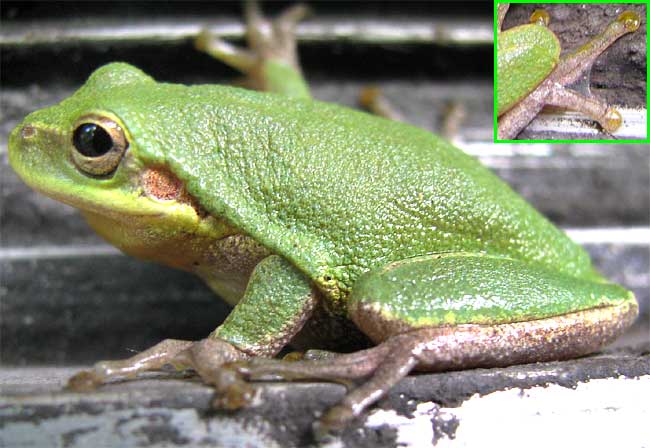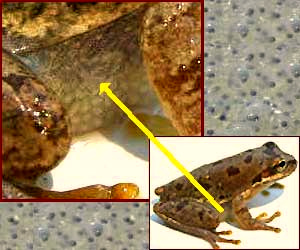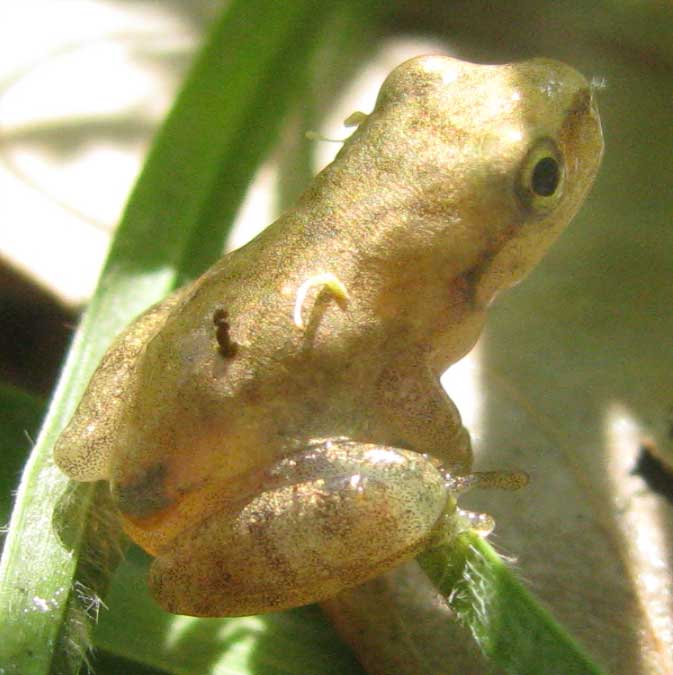Excerpts from Jim Conrad's
Naturalist Newsletter

from the June 30, 2008 Newsletter, issued from the forest near Natchez, Mississippi; elevation ~400ft (120m), ~N31.47°, ~W91.29°:
A SQUIRREL TREEFROG
With all this storm activity the treefrogs around my porch next to the woods were in their element. Often during the day for no apparent reason a chorus of them would break out calling. Other times they'd be set off by sudden claps of thunder, or even by my scraping the chair on my floor as I got up from the computer. Once I even set off a chorus by issuing a healthy hermit fart.
Basically I live on my open porch, using my attached smaller trailer just as a library. I haven't bothered removing the trailer's window coverings, which can be tilted up to make simple awnings. In the dark, moist spaces beneath those coverings, that's where treefrogs like to hold out during the day between rains. You can see a frog photographed when I lifted a covering up at the top of this page.
You know that that individual is a treefrog because it's so small, about an inch, and because its toes end with largish, round tips, which are sticky adhesive pads enabling him to climb walls and not fall out of trees. In the above picture at the upper right there's a close-up of the frog's toe pads.
Treefrogs belong to the Treefrog Family, the Hylidae. In this area we have five frog families represented: the "true frogs"; toads; narrow-mouthed frogs; spadefoot toads, and; treefrogs. With us the Treefrog Family provides the greatest number of frog species.
Identifying the treefrog in the picture wasn't as easy as you might think. The Audubon field guide shows three almost-all-green treefrogs for our area -- the Barking, Green and Squirrel -- and each of those species is variably colored. Using the Internet to view a variety of pictures, I decided I probably had a Squirrel Treefrog, HYLA SQUIRELLA, which is distributed in the US Deep South on the Coastal Plain. I became confident in my identification only when I found an online recording of the Squirrel Treefrog's mating call. Possibly you can hear several variations of the Squirrel Treefrog's call on CaliforniaHerps.Com's Sounds of Squirrel Treefrog page.
from the April 4, 2004 Newsletter, issued from near Natchez, Mississippi:
SQUIRREL TREEFROG FULL OF EGGS
The other day Hillary on the Mississippi Gulf Coast sent me an interesting picture of a Squirrel Treefrog. He'd taken his car to a car wash and this frog emerged from the vehicle, apparently enticed by the car wash's water. The frog's belly was absolutely stuffed with eggs, which you could plainly see through the frog's stretched belly skin! That's the picture below:

from the April 8, 2012 Newsletter, issued from the forest near Natchez, Mississippi; elevation ~400ft (120m), ~N31.47°, ~W91.29°:
TREEFROG IN CLOVER
A broad swath of the seldom-mowed lawn here is snowy with flowering White Clover. I was down on my knees and elbows chasing a butterfly when something tiny jumped right beneath me. It was a young frog no larger than my thumbnail. That's him perching on a grass blade below.

Sunlight glows through his translucent back legs below.

In that picture I think we can see his femurs and femoral arteries, and I wonder how such fragile-looking little legs can make the powerful leaps that carried him from grass blade to grass blade as I chased him.
This is a Squirrel Treefrog, HYLA SQUIRELLA, one of our most commonly encountered treefrogs, and found throughout the US Deep-South Coastal Plain.